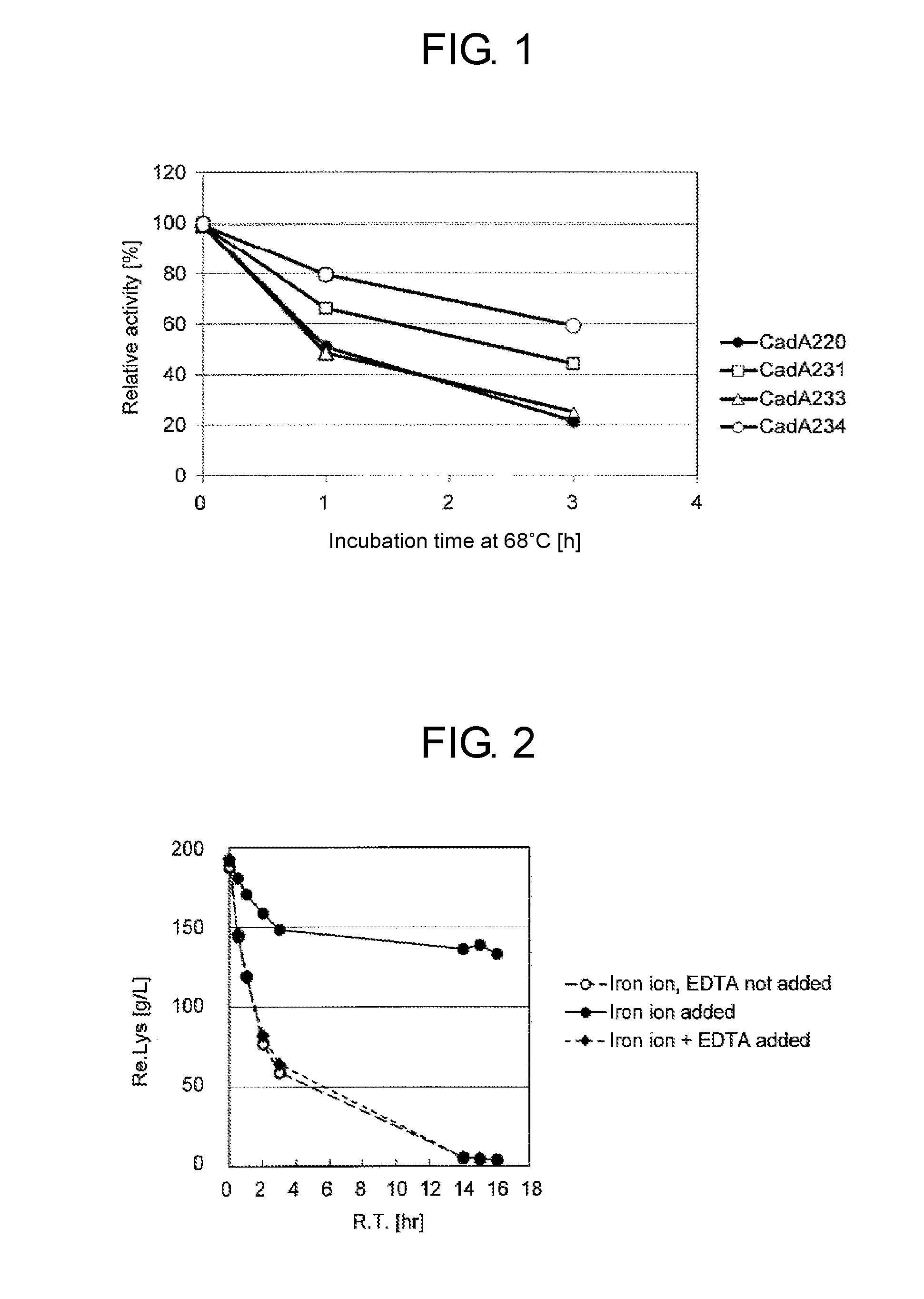Method of Producing 1,5-Pentadiamine Using Lysine Decarboxylase Mutant Having Improved Thermal Stability
a technology of lysine decarboxylase and thermal stability, which is applied in the direction of lyases, carbon-carbon lyases, enzymology, etc., can solve the problems of inability to efficiently produce 1,5-pd and inability to disrupt microorganisms in large amounts, and achieve the effect of efficient production of 1,5-pd
- Summary
- Abstract
- Description
- Claims
- Application Information
AI Technical Summary
Benefits of technology
Problems solved by technology
Method used
Image
Examples
example 1
Cloning of Lysine Decarboxylase Gene (cadA) Derived from Escherichia coli, Introduction of Mutation, and Screening of Mutant Having Improved Thermal Stability
[0065](1) Cloning of cadA Gene and Construction of Expression Library of Mutated Lysine Decarboxylase (CadA)
[0066]A DNA fragment including a lysine decarboxylase gene (cadA) was amplified by PCR method using genomic DNA of Escherichia coli W3110 (ATCC39936) as a template according to the method described in Example 1 in JP patent application laid-open Publication No. 2008-193899. This fragment was ligated to a modified acid phosphatase promoter derived from genus Enterobacter at a XbaI-PstI site in the high-expression plasmid pUC19 (Takara Bio Inc.) and designated pCadA220.
[0067]Escherichia coli XL1-Red competent cells (Agilent Technologies) used for introduction of random mutation were transformed with pCadA220. The resulting transformants were inoculated to 3 mL of LB medium containing 100 μg / mL of ampicillin, and cultured at...
example 2
Analysis of Mutation Site of Mutated Lysine Decarboxylase (CadA) and Evaluation of Stability
[0071](1) Analysis of Mutation Site of Mutated Lysine Decarboxylase
[0072]Plasmids were prepared from the culture medium of the transformants of E. coli JM109 retaining the mutated CadA gene obtained in Example 1, and designated as pCadA231, pCadA232 and pCadA233, respectively.
[0073]Their nucleotide sequences were determined in 310 Genetic analyzer(ABI) by a Dye Terminator method using DNA Sequencing Kit Dye Terminator Cycle Sequencing Ready Reaction (PERKIN ELMER) to confirm an introduced mutation and a substituted site of a mutated amino acid residue. The nucleotide sequences were analyzed using primers shown in Table 1.
TABLE 1Nucleotide sequences of primersPrimerNucleotide sequence (SEQ ID)M13 Primer RV5′-CAGGA AACAG CTATG AC-3′(SEQ ID NO: 3)cadaf15′-CTAATA AGATC AAGCA GAC-3′(SEQ ID NO: 4)cadaf25′-CTGAC CCACC TGATG ATG-3′(SEQ ID NO: 5)cadaf35′-TGACG TAAAC GAAGA AAC-3′(SEQ ID NO: 6)cadaf45′-...
example 3
Construction of Combined Combination Mutant and Evaluation of its Stability
[0078]A combination mutant for increasing the amount of expressed CadA was constructed using QuikChange™ Site-Directed Mutagenesis Kit (Stratagene). A mutation to alter from Val (GTT) to Ile (AAT) at position 3 was introduced using the plasmid pCadA233 as the template and using oligonucleotides v3i_r (5′-cat gtg att caa tat tgc aat aat gtt cat cta cat tcc tcc tta cg-3′(SEQ ID NO:11)) and v3i_f (5′-cgt aag gag gaa tgt aga tga aca tta ttg caa tat tga atc aca tg-3′ (SEQ ID NO:12)) as primers according to a protocol. The nucleotide sequence of the constructed plasmid was determined by the method described in Example 2 to confirm that the objective mutation had been introduced, and this plasmid was designated as pCadA234. An outline of the plasmids including the polynucleotide encoding the mutated enzyme is shown in Table 4. Microbial cells of E. coli JM109 / pCadA234 expressing this double mutant CadA234 at high le...
PUM
| Property | Measurement | Unit |
|---|---|---|
| Fraction | aaaaa | aaaaa |
| Temperature | aaaaa | aaaaa |
| Temperature | aaaaa | aaaaa |
Abstract
Description
Claims
Application Information
 Login to View More
Login to View More - R&D
- Intellectual Property
- Life Sciences
- Materials
- Tech Scout
- Unparalleled Data Quality
- Higher Quality Content
- 60% Fewer Hallucinations
Browse by: Latest US Patents, China's latest patents, Technical Efficacy Thesaurus, Application Domain, Technology Topic, Popular Technical Reports.
© 2025 PatSnap. All rights reserved.Legal|Privacy policy|Modern Slavery Act Transparency Statement|Sitemap|About US| Contact US: help@patsnap.com

